Content is from Kirkbride et al. 2006Kirkbride et al. 2006:
Kirkbride JH, Jr, Gunn CR, and Dallwitz MJ. 2006. Family guide for fruits and seeds, vers. 1.0. Accessed September 2020-January 2022. URL: https://nt.ars-grin.gov/seedsfruits/keys/frsdfam/index.cfm ., without modification.
Updates are forthcoming.
Family name: Aceraceae A.L. Jussieu
Common name: Maple Family.
Number of genera: 2 genera.
Number of species (Mabberley 1997): 113 species.
Fruits: Pistil(s) compound; 1; 1-pistillate; with carpels united. Fruit pericarpium; schizocarpschizocarp:
usually dry fruit splitting between two or more locules to form distinct, indehiscent, usually one seeded segments; fruit derived from a single, superior or inferior, compound ovary; compare to mericarp ; samarium (Acer Spjut Fig. 47D); without persistent central column; not within accessory organ(s); more than 1 but less than 10-seeded, or 1-seeded; (1–)2-seeded; with 2-carpellate; with carpels united; with carpels remaining united at maturity, or separating at maturity; with carpels not radiating at maturity; with carpels remaining connected at stylestyle:
; samarium (Acer Spjut Fig. 47D); without persistent central column; not within accessory organ(s); more than 1 but less than 10-seeded, or 1-seeded; (1–)2-seeded; with 2-carpellate; with carpels united; with carpels remaining united at maturity, or separating at maturity; with carpels not radiating at maturity; with carpels remaining connected at stylestyle:
in a flower, the narrow and elongated part of the pistil between the stigma and the ovary; sometimes persisting in fruit , or separating at stylestyle:
, or separating at stylestyle:
in a flower, the narrow and elongated part of the pistil between the stigma and the ovary; sometimes persisting in fruit (Cronquist: Eventually separating from persistent carpophorecarpophore:
(Cronquist: Eventually separating from persistent carpophorecarpophore:
the stalk supporting a mericarp after dehiscence of a schizocarpic fruit, the central axis of the fruit having split longitudinally to yield two or four such stalks; composed of receptacular and (primarily) gynoecial tissues, esp. in Apiaceae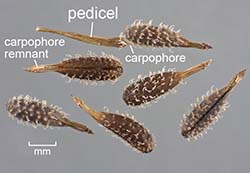 ); without sterilesterile:
); without sterilesterile:
lacking male and/or female reproductive parts; also, not producing fruit or seed
 carpels; not sulcatesulcate:
carpels; not sulcatesulcate:
surface relief—having one or more elongate, relatively narrow and shallow depressions or grooves ; apexapex:
; apexapex:
the point farthest from the point of attachment, or the "tip" of an organ not beaked; wall leatheryleathery:
not beaked; wall leatheryleathery:
texture—moderately thick, tough, and very pliable
, or membranaceous; indehiscentindehiscent:
not opening on its own, as in a fruit
 . Epicarpepicarp:
. Epicarpepicarp:
outer layer of fruit wall or pericarp, if divided into layers; note here used synonymously with exocarp brown (all shades), or green; durable; glabrousglabrous:
brown (all shades), or green; durable; glabrousglabrous:
without hairs
; without armature; smooth; with wing(s); 2-winged (usually and a schizocarpschizocarp:
usually dry fruit splitting between two or more locules to form distinct, indehiscent, usually one seeded segments; fruit derived from a single, superior or inferior, compound ovary; compare to mericarp of 2, 1-seeded mericarpsmericarp:
of 2, 1-seeded mericarpsmericarp:
a one-seeded section (carpel) of a schizocarp, as in Apiaceae fruits (compare schizocarp)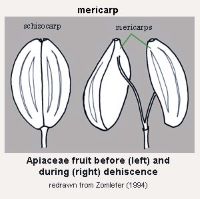 ); with wing(s) laterallateral:
); with wing(s) laterallateral:
(of embryo) embryo lies along the side of the seed, generally towards one end; of, at, or from the side; in grasses, can refer to the sides adjacent to the dorsal and ventral sides
; without apicalapical:
at or pertaining to the end of the seed or fruit distal from its point of attachment (i.e., base)
respiratory hole. Mesocarpmesocarp:
the middle layer of the pericarp, if divided into layers absent. Endocarpendocarp:
absent. Endocarpendocarp:
the inner layer of the pericarp, if divided into layers present; not separating from exocarpexocarp:
present; not separating from exocarpexocarp:
outer layer of fruit wall or pericarp, if divided into layers; note here used synonymously with epicarp ; thin, or woodywoody:
; thin, or woodywoody:
texture—consisting mainly of indurate lignified tissues, characteristic of or resembling wood
; not splitting into 1-seeded pyrenes; smooth; without operculumoperculum:
a dehiscent cap (or lid) of a seed or fruit that opens during germination or dehiscence ; without secretory cavities; without longitudinallongitudinal:
; without secretory cavities; without longitudinallongitudinal:
of or relating to length or the lengthwise dimension
ridges. Funiculusfuniculus:
(alt. funicle) stalk connecting the ovule (later seed) to the ovary (later fruit) placenta short; short without seed bearing hookswith hooks:
short; short without seed bearing hookswith hooks:
bristles or spines with curved or backwards pointing tips, or with secondary bristles along their length (retinacula); not persisting in fruit after seed shed.
(retinacula); not persisting in fruit after seed shed.
Seeds: Arilaril:
(broad sense) appendicular structure that wholly or partly envelops a seed and is produced from or a modification of the funicle, raphe, or outer integument; usually fleshy or pulpy, sometimes spongy or tufted-capillate, often brightly colored absent. Seed larger than minute; ovateovate:
absent. Seed larger than minute; ovateovate:
2D shape—egg-shaped in outline, widest point is towards one end of the organ, the other end tapers gradually, attachment at or near the broad end (compare obovate, ovoid) ; in transection compressedcompressed:
; in transection compressedcompressed:
flattened; in grasses, used to denote compression (not necessarily flattened) either laterally or dorsiventrally
; not bowl shaped; not nutlike; without winglike beakbeak:
a usually firm, terminal appendage, sometimes tapered ; without caudatecaudate:
; without caudatecaudate:
tapering to a long, tail-like appendage appendage(s); at maturity without food reserves (absent from mature seed); without canavanine. Sarcotestasarcotesta:
appendage(s); at maturity without food reserves (absent from mature seed); without canavanine. Sarcotestasarcotesta:
pulpy or fleshy outer layer of the seed coat, simulates aril absent. Testatesta:
absent. Testatesta:
seed coat
 present, or absent; vestigial (thin and function assumed by pericarppericarp:
present, or absent; vestigial (thin and function assumed by pericarppericarp:
fruit wall or fruit coat
); without embryo surrounded and capped by viscid tissue; without fleshy or leatheryleathery:
texture—moderately thick, tough, and very pliable
layer over hard layer; surface smooth, or unsmooth; surface with merged raised features; surface reticulatereticulate:
surface relief—netted, raised walls or concave grooves forming a net-like surface pattern with flat, concave, or convex interspaces , or wrinkledwrinkled:
, or wrinkledwrinkled:
surface relief—shallow, irregular folds and furrows covering the surface; appearing overall though crumpled and then spread out (slightly); with crease or line separating cotyledons from hypocotyl-radicle; with notch along margin where cotyledons from hypocotyl-radicle tip approaching each other; without glands; without bristles; without wings; without collar; without operculumoperculum:
(slightly); with crease or line separating cotyledons from hypocotyl-radicle; with notch along margin where cotyledons from hypocotyl-radicle tip approaching each other; without glands; without bristles; without wings; without collar; without operculumoperculum:
a dehiscent cap (or lid) of a seed or fruit that opens during germination or dehiscence ; colored; monochrome; thin; not becoming mucilaginousmucilaginous:
; colored; monochrome; thin; not becoming mucilaginousmucilaginous:
resembling mucilage; moist and sticky
when wetted; surrounding embryo. Embryo differentiated from food reserve; well developed; 1 per seed; partially filling testatesta:
seed coat
 (with food reserve); 0.6 times the length of food reserve; at one end of seed not extending into a depression or cup; axileaxile:
(with food reserve); 0.6 times the length of food reserve; at one end of seed not extending into a depression or cup; axileaxile:
on or of the axis
and centric; foliatefoliate:
appearing leaf-like
; with investinginvesting:
(of embryo) embryo is nearly or completely filling seed coat, straight, and axile and centric with spatulate cotyledons and covering the stalk for at least half its length; (of cotyledons) cotyledons spatulate and covering the stalk for at least half its length
cotyledons; bentbent:
(of embryo) embryo is bent at an acute, V-shaped angle with the ends close together and generally thick cotyledons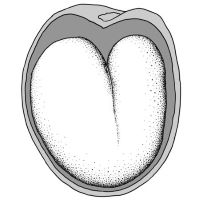 , or flatly coiledcoiled:
, or flatly coiledcoiled:
(of embryo) linear embryo is very long and bent to form a coil whereby one end of the embryo is on the outside and the other end near the middle of the seed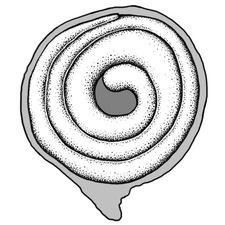 (circinatecircinate:
(circinatecircinate:
3D shape—terete and rolled downward from the apex in a tight coil
); without coleorhiza; without simmondsin; with cotyledons containing oils, or starch; without stomata; green (cotyledons); with 2 or more cotyledons. Cotyledons 2; well developed; 0.6 times length of embryo; somewhat to significantly wider than hypocotyl-radicle; 4 times wider than hypocotyl-radicle; obliquely incumbentincumbent:
(of cotyledons) having the dorsal side of one cotyledon resting against the radicle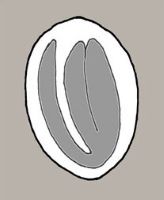 to hypocotyl-radicle; thin; irregularly-folded, or convoluted; equal in size; not punctatepunctate:
to hypocotyl-radicle; thin; irregularly-folded, or convoluted; equal in size; not punctatepunctate:
surface relief—dotted with pits or with translucent, sunken glands or with colored dots, similar to pitted dotted. Hypocotyl-radicle well developed; not thickened.
dotted. Hypocotyl-radicle well developed; not thickened.
General distribution: Pantemperate (northern). New World and Old World.
Detailed distribution: North America, Europe, and Asia Major.
General references: Corner, E.J.H. 1976. The seeds of Dicots, esp. vol. 2. Cambridge University Press, New York, Cronquist, A. 1981. An integrated system of classification of flowering plants, 1,262 p. Columbia University Press, New York, Goldberg, A. 1986 (dicots) & 1989 (monocots). Classification, evolution, and phylogeny of the familes of Dicotyledons. Smithsonian Contr. Bot. 58 for dicots (314 pp.) & 71 for monocots (74 pp.). [Goldberg's illustrations are reproduced from older publications and these should be consulted], Gunn, C.R., J.H. Wiersema, C.A. Ritchie, & J.H. Kirkbride, Jr. 1992 & amendments. Families and genera of Spermatophytes recognized by the Agricultural Research Service. Techn. Bull. U.S.D.A. 1796:1–500, Schopmeyer, C.S. 1974. Seeds of Woodywoody:
texture—consisting mainly of indurate lignified tissues, characteristic of or resembling wood
plants in the United States. Agric. Handb. 450:1–883, Spjut, R.W. 1994. A systematic treatment of fruit types. Mem. New York Bot. Gard. 70:1–182, Wood, C.E., Jr. 1974. A student's atlas of flowering plants: Some dicotyledons of eastern North America, 120 pp. Harper & Row, New York, and Mirle, C. & R.J. Burnham. 1999. Identification of asymmetrically winged samarassamara:
a winged, indehiscent, dry fruit containing a single (rarely two) seed(s) from the Western Hemisphere. Brittonia 51:1–14.
from the Western Hemisphere. Brittonia 51:1–14.